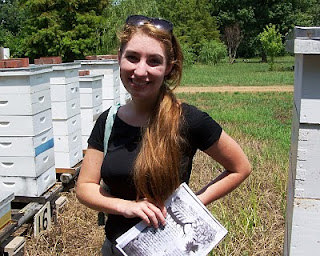The Anglo-Saxons formed the English nation. Kayla Miller, a senior at Rhodes College in Memphis, is studying Anglo-Saxon writings. After translating an eighth century piece, known as a metrical charm, she discovered the writing involved honey bee swarming. To provide some background information, she came out to the bee farm to visit, see some bee hives, and discuss honey bee swarming. Here is her translation of the 12-hundred-year-old piece, Against a Swarm:
Take dirt
Throw it over-head with your right hand
Throw it under-foot
Step on it with the right foot and say;
I seize it under-foot;
I found it.
Indeed. Earth has power
Against every creature,
And against hatred
And against enmity
And against the great tongue of man.
Cast earth over them
When they swarm and say:
Sit you victory women
Sink to the earth.
May you never wildly
To the woods fly!
Be as mindful of my welfare
As every man of food and property.
The language of English-speaking people has changed considerably over the past 12 hundred years; however I recognize some issues with dealing with honey bees and fellow people persist over hundreds of years. The act of throwing dirt over-head in the presence of swarming bees reminds me of the European custom known as tanging, involving clashing together pots and pans or ringing bells. The tradition of tanging persisted until recently. Many felt that the noise settled the swarming bees; actually tanging was dictated by an English king as a method of signaling to others that the noise-maker claimed ownership of the swarm of bees. Honey bees were especially valuable as a source of honey as a sweetener and beeswax for candle light. Every beekeeper that has gathered swarms knows the disappointment of having a swarm take flight and fly to the woods. The last sentence of the charm speaks of the value of the honey bee as food and property. In the picture, Kala visits Peace Bee Farm with the manuscript, Against a Swarm.
--Richard





Awesome - I shared this blog post on my ethnobeeology facebook page - thanks Kayla Miller and Peace Bee Farm.
ReplyDelete